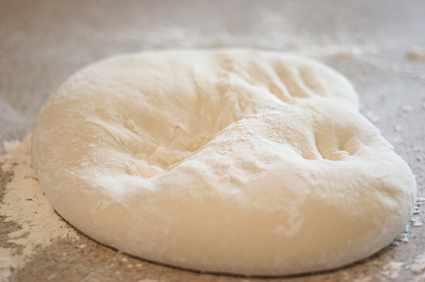 Fifteen minutes wrestling with dough–who kneads it?
Fifteen minutes wrestling with dough–who kneads it?
A little more than two years ago, Mark Bittman and Jim Lahey got together and transformed home bread making for all time. In the kitchen of Lahey’s Sullivan Street Bakery, they shot a video illustrating Lahey’s simple method for making a top-quality loaf with no special equipment–and no kneading whatsover. If you haven’t seen it, you really have to watch it (damn The New York Times for not making its videos embeddable.)
Bittman wasn’t exaggerating when he wrote at the time:
INNOVATIONS in bread baking are rare. In fact, the 6,000-year-old process hasn’t changed much since Pasteur made the commercial production of standardized yeast possible in 1859. The introduction of the gas stove, the electric mixer and the food processor made the process easier, faster and more reliable.
I’m not counting sliced bread as a positive step, but Jim Lahey’s method may be the greatest thing since.
It’s no joke: Lahey’s technique counts as an honest-to-goodness innovation in bread-making–and one that genuinely empowers home cooks. Lahey delivered two masterstrokes: 1) by letting dough sit overnight, its glutens develop without the need for kneading; and 2) by cooking the dough in a blazing hot, tight lidded, heavy-bottomed pot, you mimic the conditions of a fancy bakery oven.
The early adapters to Lahey’s idea were people like me: passionate home cooks who had for years laboriously kneaded dough to make pretty-good home bread. With the exception of those truly hardcore fanatics among us, those willing to spend days on a loaf, we were making good bread, but not getting the rustic, chestnut-colored crusts and soft, air-hole-marked crumb of truly great bread. To have that in your life, you generally had to live near one of the country’s few excellent bakeries.
For us, Lahey’s technique was a revelation. I sometime miss the physical process of kneading, the feeling of getting one’s hands into one’s food, but I’ve been using the no-knead method ever since the Bittman article came out.
And now, with all the recent buzz around home cooking–sparked by Michael Pollan’s summer 2009 essay–the no-knead juggernaut is gaining new steam.
During the recent East Coast snowstorms, Washington D.C. home-baking legend–and food politics writer–Sam Fromartz published Lahey’s recipe on his blog, and declared a “snowpocolypse baking challenge” urging people to spend some of their snowed-in time baking bread. The idea was kind of ironic, given that Lahey’s recipe takes no more than about 15 minutes of active fussing; but Fromartz is right that people need a spur, an excuse, to get them to try something new. In this post, he highlights the challenge’s winners, many of them first-time bakers. You, too, can make professional-quality bread in your kitchen!
And today, The New York Times published a piece by the great food-science writer Harold MgGee taking a close look at the no-knead technique. His verdict: It works! McGee also adds some important nuance to the discussion–as well as an appealing recipe for whole-wheat bread that requires just two minutes of kneading.
Speaking of whole wheat flour, I’ve been quite happily using the Lahey technique with half whole-wheat and half white flour. I find that it’s superb out of the oven, and quite wonderful the next day, after being toasted.
So, get baking!



